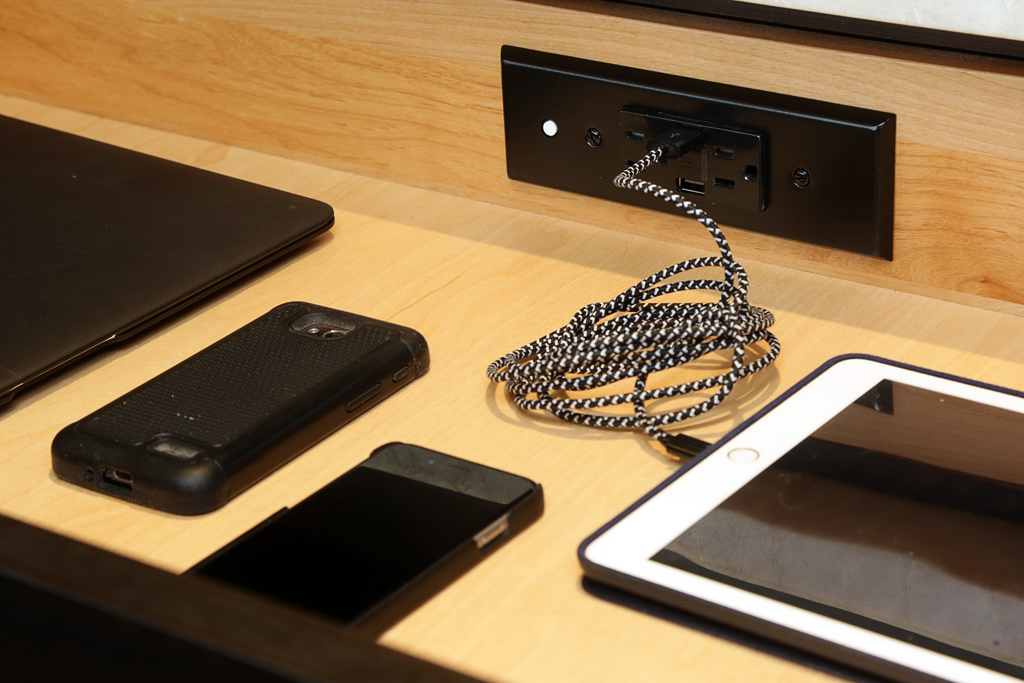Sure, you’ve heard about Docking Drawer outlets–but do you know how to add an in-drawer outlet into your kitchen cabinets or other RTA cabinet ensembles?
Remember: Install In-Drawer Outlets Safely
Unlike popular DIY in-drawer power strips or your contractor using off the shelf electrical components, Docking Drawer in-drawer outlets are safe and reliable. Additionally, they offer interlocking safety features that cut power to the outlet in the event of an emergency to help minimize risk. In-drawer electrical strip hacks can’t do that!
Specifying a Docking Drawer in-drawer outlet for your is easy as long as you plan ahead. We’ve made it simple to learn our specification process and this blog will walk you through those steps one at a time.
First, Choose a Location
Take control of clutter by creating in-drawer charging or powering stations. Kitchen cabinets make fantastic locations for extra outlets. Have a need for an outlet somewhere else? You can also use Docking Drawer outlets to create charging stations in night stands, desks, and drop zones. No matter which space you choose, you can be sure a Docking Drawer will help you stay plugged in.
Second, Choose the Right Outlet
Based on your application, Docking Drawer, offers two types of outlets. To decide what your application is, ask yourself these two questions:
#1 – Will the outlet be used to charge phones, tablets, and laptops?
#2 – Will the outlet be used to power a hair dryer, hand mixer, or power tools?
If you answered yes to question #1, choose a charging outlet for your project.
If you answered yes to question #2, choose a powering outlet for your project.
Charging Outlets
Designed to charge technology such as smartphones, tablets, and laptops, in-drawer charging outlets are ideal for clearing and organizing technology clutter by creating in-drawer charging stations. Most commonly specified in kitchen cabinets, charging outlets can charge up to 4 devices simultaneously. They feature a UL Listed circuit breaker that limits the AC output to 3amps and prevents high power devices such as hair dryers from being used to minimize risk and ensure safe operation.
Powering Outlets
These outlets are designed for applications requiring more than 3amps such as hair dryers, appliances, tools, and similar. Most commonly specified into bathrooms, powering outlets feature a 20 amp, GFCI tamper resistant outlet including an integrated thermostat that cuts power to the outlet in the event that the surrounding temperature exceeds 120 degrees. This help to minimize risks. Powering Outlets are perfect for bathroom vanities and other applications requiring full power.
Third, Choose an Outlet
Here is a step by step guide to specifying an outlet into your projects:
1. Docking Drawer outlets are sized by cabinet depth. This is the measurement from the front to the back of the cabinet itself, not the drawer. Review the cabinet depth to confirm the maximum extension needed to ensure the drawer opens completely. For example, if your cabinet is 24” deep then specify an outlet with 24 in the name of the product.
** Please note, that choosing a smaller sized outlet will prevent the drawer from pulling out fully. **
2. With the cabinet depth and extension needed understood, confirm the width available behind the drawer box to ensure the outlet will fit. If you do not have enough width we have a solution for you. See Narrow Drawer Installation Tips in the Installation Library. This solution is ideal over using a smaller unit in which the drawer will be limited to how far it can pull out.
3. Confirm the space from the back of the drawer box to the back of the cabinet before checking the spec of the outlet you choose. Is there enough room for the in-drawer outlet to fit? If so, you’re on the right track! If not, don’t worry! This just means you need to specify the next size down drawer box. For example, a 24” deep cabinet typically has a 21” deep drawer box.
** Note: If this space is not available see Retro Fit tips in the Installation Library. **
4. Finally, confirm the minimum interior drawer box height to accommodate the receptacle box.
Fourth, Plan Ahead
Now that you have:
- Picked a location to install your in-drawer outlet
- Selected either a charging or a powering outlet based on your application
- Chosen an outlet that provides enough extension to allow your drawer to open completely which also fits in the open space behind the drawer box…
…it is time to plan your in-drawer outlet installation! Don’t worry–Docking Drawer has created two technical libraries to make planning incredibly simple.
Docking Drawer Specification Library
The Docking Drawer Specification Library contains all of the technical resources you will need to specify an in-drawer outlet including:
- Submittal documents
- Mounting Diagrams detailing dimensions for space planning and receptacle box cut out dimensions
- DXF and STEP files for importing into 2D and 3D design programs
Docking Drawer Installation Library
The Docking Drawer Installation Library contains all the resources you will need to install an in-drawer outlet including:
- Electrical Planning Guide detailing how to bring in and locate power for an in-drawer outlet
- Installation planning tips and tricks for narrow drawers, retrofit tips, etc.
- In-Drawer outlet installation instructions
- Wiring diagrams
Summary
Congratulations! You just specified your first in-drawer outlet and you are well on your way to becoming a specification expert.
Always remember these 3 key concepts:
- Choose the right outlet based on application
- Size by cabinet depth
- Confirm Docking Drawer outlet fit into the space behind the drawer box
If you still need help or have a unique situation that requires in-drawer outlets, just call us. We are here to help and would be happy to work with you to specify the right outlet.
Reposted with permission from Docking Drawer. Ready to source an outlet? Browse our selection of Docking Drawer outlets here or call us at 262-375-7960.

